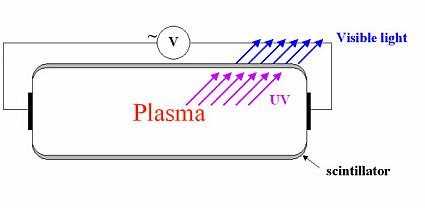LCD Or Plasma - What's Your Pleasure? Understanding Modern Flat-Panel TV Technologies
A "Simple" Basic Principle
The basic idea behind the operation of plasma displays is fairly simple: each sub-pixel is a microscopic fluorescent lamp that emits one primary color - red, green, or blue. By varying the intensity of the light from these three sub-pixels, a multitude of tints can be displayed.
The principle behind a plasma display is the same one that makes the fluorescent tubes we're all familiar with work: a rare gas (argon, for example) is sealed inside a tube. At each end of the tube are electrodes to which high-voltage electricity (several hundred volts) is applied. The rare gas is electrically neutral, but the excitation by the current transforms it into plasma, a gas made up of both free electrons and positive ions (the sum of the charges remains neutral). Due to the difference in potential of several hundred volts, the electrons flow toward the positive electrode, while the positive ions are attracted to the tube's negative terminal. These movements produce impacts between atoms. When each atom is impacted, it gains energy and its electrons move to a higher-energy orbit. When they return to their initial orbit, they give off a photon: a "quantum" of light.
The light that's given off is the result of the movement of the plasma under the effect of a strong electrical field. But applying a continuous difference of potential to the tube's terminals is not enough. The plasma must be kept in continual movement in order for it to emit light, and so an alternating current is applied to the terminals. This voltage causes the gas ions to migrate from one terminal to the other, back and forth.
However, there's a problem. The light emitted by the plasma isn't visible: it's ultraviolet radiation, and UV is invisible to humans, so it has to be changed into visible form. To do this, the walls of the tube are coated with a UV-sensitive powder that emits white light (in the case of conventional lighting tubes). This powder, often called phosphor, is a scintillator: a material that converts one form of radiation to another.
The use of scintillators is not new in display technologies. Cathode Ray Tubes (CRTs) contain scintillators that convert the electron beam into red, green, or blue light.
Get Tom's Hardware's best news and in-depth reviews, straight to your inbox.
Current page: A "Simple" Basic Principle
Prev Page Plasma Technology Next Page From Fluorescent Tube To Plasma Pixel